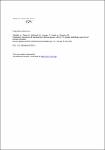Population structure of Salmonella enterica serovar 4,[5],12:b:- strains and likely sources of human infection
Toboldt, Anne
Tietze, Erhard
Helmuth, Reiner
Junker, Ernst
Fruth, Angelika
Malorny, Burkhard
Salmonella enterica serovar 4,[5],12:b:- is a monophasic serovar not able to express the second-phase flagellar antigen (H2 antigen). In Germany, the serovar is occasionally isolated from poultry, reptiles, fish, food, and humans. In this study, a selection of 67 epidemiologically unrelated Salmonella enterica serovar 4,[5],12:b:- strains isolated in Germany between 2000 and 2011 from the environment, animal, food, and humans was investigated by phenotypic and genotypic methods to better understand the population structure and to identify potential sources of human infections. Strains of this monophasic serovar were highly diverse. Within the 67 strains analyzed, we identified 52 different pulsed-field gel electrophoresis XbaI profiles, 12 different multilocus sequence types (STs), and 18 different pathogenicity array types. The relatedness of strains based on the pathogenicity gene repertoire (102 markers tested) was in good agreement with grouping by MLST. S. enterica serovar 4,[5],12:b:- is distributed across multiple unrelated eBurst groups and consequently is highly polyphyletic. Two sequence types (ST88 and ST127) were linked to S. enterica serovar Paratyphi B (d-tartrate positive), two single-locus variants of ST1583 were linked to S. enterica serovar Abony, and one sequence type (ST1484) was associated with S. enterica serovar Mygdal, a recently defined, new serovar. From the characterization of clinical isolates and those of nonhuman origin, it can be concluded that the potential sources of sporadic human infections with S. enterica serovar 4,[5],12:b:- most likely are mushrooms, shellfish/fish, and poultry.
Dateien zu dieser Publikation
Keine Lizenzangabe
Verwandte Publikationen
Anzeige der Publikationen mit ähnlichem Titel, Autor, Urheber und Thema.
-
2013-03-21ZeitschriftenartikelTyping of Salmonella enterica serovar Infantis isolates from 51 outbreaks in Germany between 1974 and 2009 by a novel phage-typing scheme Miller, Tatjana; Braun, Peggy; Fehlhaber, K.; Prager, Rita; Pfeifer, Yvonne; Rabsch, WolfgangWe developed a new phage-typing method and evaluated its application in combination with XbaI macrorestriction analysis by pulsed-field gel electrophoresis (PFGE) as a useful tool for the long-term epidemiology of Salmonella ...
-
2010-05-14ZeitschriftenartikelPork contaminated with Salmonella enterica serovar 4,[5],12:i:-, an emerging health risk for humans. Hauser, Elisabeth; Tietze, Erhard; Helmuth, Reiner; Junker, Ernst; Blank, Kathrin; Prager, Rita; Rabsch, Wolfgang; Appel, Bernd; Fruth, Angelika; Malorny, BurkhardSalmonella enterica subsp. enterica serovar 4,[5],12:i:- is a monophasic variant of S. enterica serovar Typhimurium (antigenic formula 4,[5],12:i:1,2). Worldwide, especially in several European countries and the United ...
-
2013-11-14ZeitschriftenartikelEvidence for the transmission of Salmonella from reptiles to children in Germany, July 2010 to October 2011 Pees, Michael; Rabsch, Wolfgang; Plenz, B.; Fruth, Angelika; Prager, Rita; Simon, Sandra; Schmidt, V.; Münch, Sebastian; Braun, PeggyThis study examines the Salmonella status in reptiles kept in households with children suffering from gastroenteritis due to an exotic Salmonella serovar, to obtain information on possible transmission paths. A number of ...

